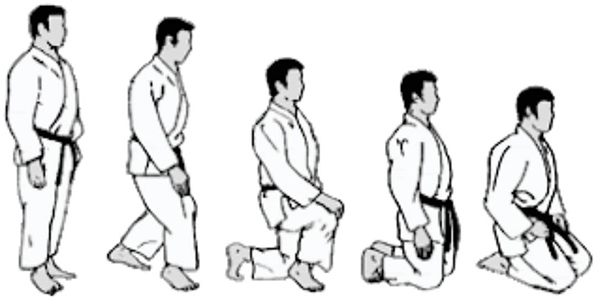by Yuki Reed
Nidan
Being Japanese, I am used to sitting seiza-style on the floor, perhaps for meals beside a low dining table. Nowadays, the Japanese find it more comfortable to sit on chairs. Most of the younger generation have been brought up without seiza, except for special occasions, such as a funeral. My grandparents could sit seiza-style for hours, whereas my capability is limited, having indulged in the western lifestyle. I really feel sorry for foreign Aikido students putting up with such an uncomfortable way of sitting.

Starting Aikido, many people have to confront the difficulty of seiza. Do not worry. You are not the only one feeling uncomfortable. Actually, it was a method of torture in the past. Seiza, which literally means "proper sitting", became the conventional Japanese way of sitting after the Edo period (the age of samurai) finished. It is said that the third Edo shogun (a military ruler of the state) ordered feudatories to sit seiza-style in front of him, to avoid him being assassinated. Samurai adapted to the foot-numbing seiza posture and developed the technique of moving swiftly to kill or not to be killed.

Japanese martial arts value courtesy and seiza is one form of that. One will gradually become flexible and be able to sit properly. To avoid numbness, sit upright and try to move your centre of gravity slightly forward rather than leaving it on the soles of your feet.
However, if you find seiza impossible, for example, if you have a knee problem, just let sensei know. Seiza is a strange culture but not torture any more.
"Quiet sitting" using the seiza posture is a way to overcome the generalized fears of life and the underlying fear of death. It is an excellent way to regulate body functions. It can bring the mind closer to the world "as it is" rather than its usual residence in "things as they should be". In other words, seiza is a method of breaking through the illusion of everyday life.
When sitting, the endless cycles of thought which are so crippling to mental health are broken and the clean freshness of simply living in the world is allowed to come forth.
Rei - Seated Bow Without a Weapon.

From a seiza position, lean forward, letting the hands slide down to the ground left hand first, then right. The thumbs and forefingers touch one another, forming a triangle. Lean forward deeply, keeping the elbows close to the knees. Raise back your torso, starting with the right hand. Like the standing bow, the depth of the bow varies.
This bow is for the altar, the kamiza and the katana. In that case, slide both hands simultaneously.
When bowing to a teacher or a person of higher rank, lean forward first and wait until this person is back up before rising. Be careful not to bow with the head and a curved back. Instead, lean the head and torso forward in one movement.
